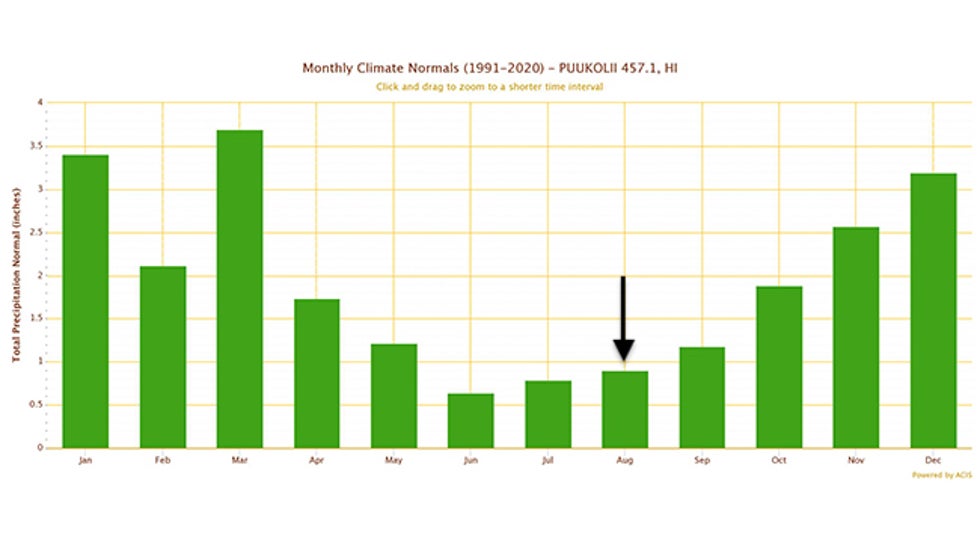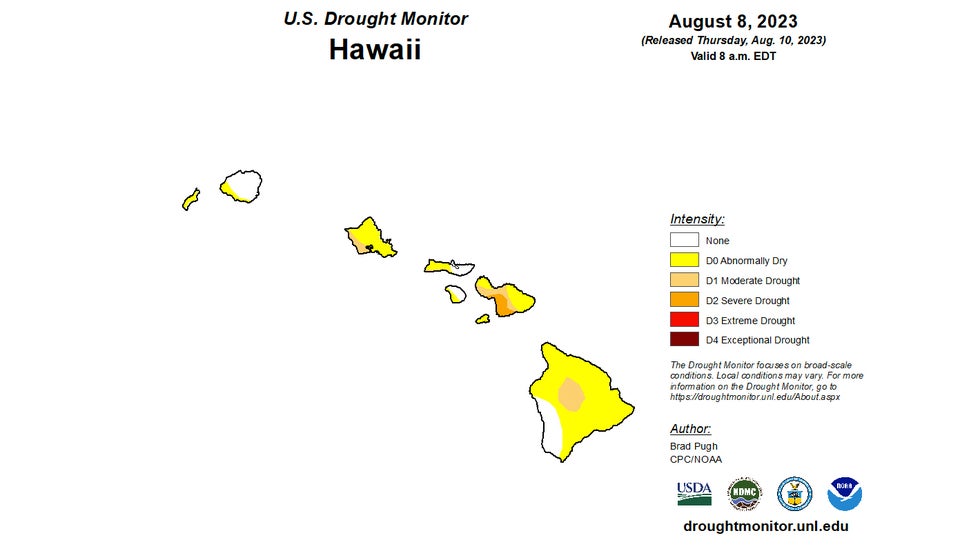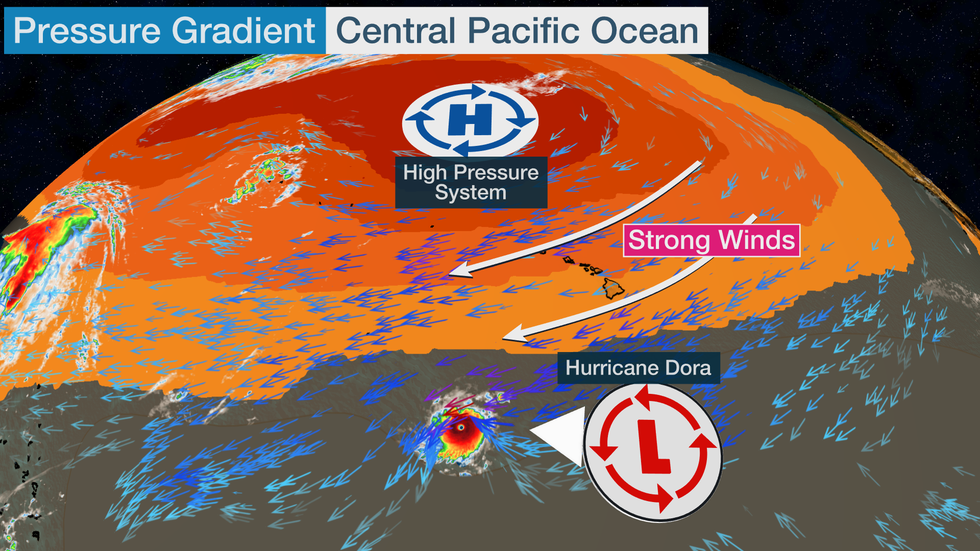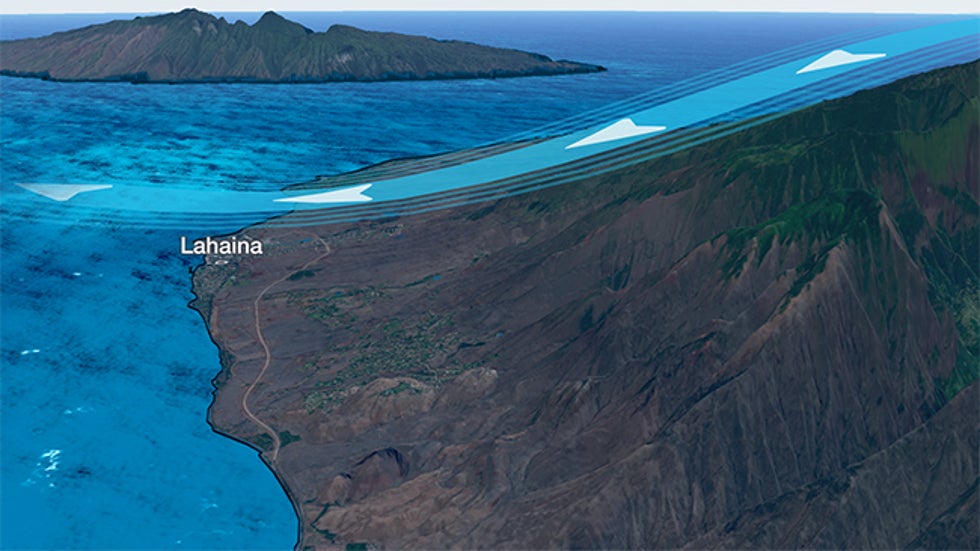Jonathan Erdman
The Maui wildfires, the deadliest and largest on record in Hawaii, were fanned by a combination of weather conditions, including drought, winds and a distant hurricane.
The fires appeared to have wiped out the historic town of Lahaina. More than 271 structures were damaged or destroyed, according to Maui County.
(MORE: Latest News Updates | How You Can Help)
Let's step through the meteorology of this event, beginning with what is typical this time of year.
It's the heart of Hawaii's dry season. First, summer is usually dry in Hawaii, as the graph below of a reporting station near Lahaina illustrates. Less than an inch of rain typically falls each month from June through August.
That's because subtropical high pressure dominates in summer. The occasional wet "Kona storms" are the domain of late fall through early spring.
 Average monthly rainfall at the Puukolii reporting station near Lahaina, Hawaii. The black arrow denotes average rainfall in August.
Average monthly rainfall at the Puukolii reporting station near Lahaina, Hawaii. The black arrow denotes average rainfall in August.But this summer has been drier than usual. That same reporting station near Lahaina only managed 0.08 inches of rain in June and 0.6 inches in July.
While a few mainly windward locations were soaked by Tropical Storm Calvin in July, Maui and other parts of the islands slipped into drought this summer.
The severity and aerial extent of drought were not impressive by historical standards, but it left vegetation such as grasses and small shrubs dried out.
Compounding that was an air mass so dry it was in the lowest 10th percentile for early August, according to atmospheric science Ph.D. candidate Tomer Burg.
 Drought Monitor analysis of Hawaii as of Aug. 8, 2023 showed moderate to severe drought in much of Maui, especially in leeward locations.
Drought Monitor analysis of Hawaii as of Aug. 8, 2023 showed moderate to severe drought in much of Maui, especially in leeward locations.It wasn't (directly) Dora's fault. East to northeast breezes in Hawaii are normal. These so-called trade winds blow because of the difference between subtropical high pressure north of the islands and lower pressure to their south.
In this case, the pressure difference was larger. The subtropical high was much stronger than usual and hurricanes as strong as Dora typically aren't roaming south of Hawaii.
Dora's most intense Category 4 winds were nowhere near Hawaii, as its center tracked hundreds of miles south of the islands.
But those two features amped up that pressure difference. The greater the pressure contrast, the stronger the winds.

The mountains made the winds worse. Virtually no discussion of Hawaii weather can happen without mentioning mountains.
Put simply, when you squeeze winds, they become stronger. In this case, they were pinched in two ways.
First, they had to press through valleys or "saddles" in the West Maui Mountains.
They were also squashed from above by an inversion, a layer of warm air that effectively restricts air from rising much. When that air is compressed between the height of the inversion and the mountain slope, it accelerates downhill and dries out further. That configuration can also produce mountain waves that only add to the wind's ferocity.
In this case, these juiced-up winds plunged down the western slope of the West Maui Mountains. They pushed the wildfire into Lahaina so quickly some people fleeing the flames were forced to jump into the water and were later rescued.
 The acceleration of winds down the slope of the mountains into Lahaina, Hawaii.
The acceleration of winds down the slope of the mountains into Lahaina, Hawaii.We've seen this before elsewhere. Removing the hurricane from the picture, this setup has some similarities with California Santa Ana wind events, as well as the deadly Camp Fire which incinerated the town of Paradise in 2018.
The National Weather Service in Honolulu said there are about four days a year in Hawaii with critical fire weather conditions, including low humidity, strong winds and dry vegetation.
What happened Tuesday wasn't just any critical fire weather day. It rewrote Hawaii's fire history.
MORE ON WEATHER.COM:
What You Can Do To Help Fire Victims
Tourists Scramble To Safety In Maui Fires
Strong El Niño Odds Are Increasing
Latest 2023 Atlantic Hurricane Season Outlook
July 2023 Was Earth's Hottest Month On Record
Jonathan Erdman is a senior meteorologist at weather.com and has been an incurable weather geek since a tornado narrowly missed his childhood home in Wisconsin at age 7. Follow him on Twitter and Facebook.
The Weather Company’s primary journalistic mission is to report on breaking weather news, the environment and the importance of science to our lives. This story does not necessarily represent the position of our parent company, IBM.
The Weather Company’s primary journalistic mission is to report on breaking weather news, the environment and the importance of science to our lives. This story does not necessarily represent the position of our parent company, IBM.

No comments:
Post a Comment